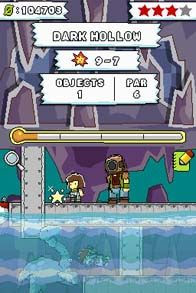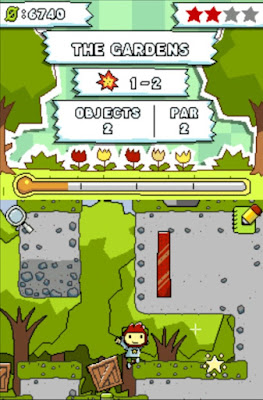 |
| Source // Nintendo |
They always say the pen is mightier than the sword, don't they? How can we best put that to the test? Pen vs Sword fight? Probably not that. What about the Nintendo DS game, Scribblenauts?
Maxwell's a clever chap with an out-of-the-box imagination - or he could have, depending on who is playing - and armed with a notebook that can summon anything into existence to help solve his problems, just like that.
That's quite a powerful pen to wield. I suppose it could even create a sword out of thin air, too. Can a sword do that?
Fun Times
For the first time in a long time I've been able to play Scribblenauts on actual Nintendo hardware, but with such an easy point-and-click control scheme, emulating it for screenshots is a piece of cake too.
Blitzing through all the mandatory tutorials leads you to the gardens of a colourful cartoon city, and the first set of puzzles for Maxwell to solve. Why is he solving puzzles? No idea. Because helping people feels good, I suppose. Let's help some folks.
As you can see, the level hint says we need to give two of these people something they'd use in their hands. What would a policeman use? Tap the notebook to open up your keyboard and get typing.
It's probably quite telling that 'Baton' is the first thing I'd think of to put in a policeman's hands, but Scribblenauts knows exactly what I mean (even if it gave me the options of 'Weapon' or 'Audio', whatever that is). Drag and drop the baton onto the policeman and he's happy with his new baton. One down, one to go.
Everything you do in a level is work towards unlocking a starite. You can't finish a level without collecting one, and when you do finish a level, you'll get scored according to how many items you summoned into existence and how quickly you got the starite, and bonus merits are awarded for using new objects, or non-lethal objects, and so on, spurring you onto experimenting with your solutions.
You could say this is abusing or exploiting the mechanics, but you could easily say it's thinking outside the box. If it allows Max to walk over and grab the butterfly, it's fair game.
This level wants you to jump further than the kid on his bike. How? Up to you. Doesn't say I have to use a bike, and driving a car down the hill resulted in bouncing off the kids head, landing on the roof, and unlocking the starite. Just as planned, I guess.
The dictionary that Scribblenauts knows is suitably large, probably larger than you'll even wrap your head around, and levels encourage you to explore it by asking for multiple objects or giving you different paths to your objective.
That said, nothing is stopping you from using what works. Ladders allow you to reach objects higher up the screen. Ladders are always used to rescue cats in high places. Could you chuck a ball and knock the cat down? Probably. Not sure what the cat or the little girl would think, but it might just be the solution you're looking for.
As well as you dragging objects around the screen and letting physics deal with it, Max has some knowledge of using objects. A stick, for example, can be thrown to knock something out of a tree, a common solution to a problem you can see in parks wherever you live.
He can only grab one thing at a time, but he knows what a container is, and knows how to put one thing inside another, like rubbish inside a bin.
Instead of moving around and trying to throw a stick at a fly, I was tearing flowers out of the ground like a yob, and making even more of a mess than when I started. Also, the fly flew off, but you can get rid of it by just grabbing it and putting it in the bin.
Humorously, you can also protect a sandwich from getting eaten by ants by simply picking up the sandwich and running away from the ants. Think outside the box, put some creativity into it, have fun.
Or is it?
Frustrations
This level was like walking into a brick wall. A gardener requires some flowers, but they're not exactly easy to reach.
In the level is an angry bee, maybe a wasp, and an angry fish, probably a piranha. These guys agro-immediately if you're within range, and won't stop attacking until you're dead, so you've got to find a way to deal with them so that you can collect some flowers.
P2 suggests I give the bee some sugar.
It's not interested in a bag of sugar, and kills me before I can use some bug spray against it - the bee continually attacked me as I was fumbling with the can. A misplaced tap of the screen can be interpreted by Max as you wanting an item to be thrown, and throwing bug spray isn't as effective as spraying it.
Bug spray at the ready before walking up to the bee, we can quickly squirt our first problem away, collect our first flower, and work out how we can deal with an angry fish. I think the answer is obvious, don't you?
The fishing rod worked, but the fish was so angry that it attacked me on land as well. Max was killed by a fish on the end of a fishing rod, on land. I was done. That's enough Scribblenauts for me.
Only it wasn't, because each world has twice as many levels as the level-select screen shows. I've been in the puzzle mode, where solutions require you to think. Evidently, I've run out of think juice, so a switch to the action mode changes the gameplay ever so slightly by giving you puzzles that are solved with a little more brute force.
A set of buttons to open gates is a puzzle, but dropping boxes to weigh the buttons down so that you can walk through to collect a starite is a little brute force.
Does this sort of gameplay sound a little more appealing? Yes, it does. Let's see how far we get.
Note to self: Elephants don't push buttons.
The action mode didn't last too long before I just ran out of brainpower. Alarmingly, it only took twenty or so minutes to get that far.
Final Word
Scribblenauts has hundreds of these puzzles and tens of thousands of recognised objects for you to use to solve them, and every single thing is as simple as thinking of a solution and seeing if it works, trying something else when it doesn't.
While most levels don't seem to care about time limits, some do, so you will have to think fast and act faster, and the touchscreen inputs can get a little messy if there's too much in the same place. It's not the most seamless of games, but for what it's striving to achieve, it's damn good.
So far as I can see, though, all the Ollar's I've been awarded for my efforts can only be spent on changing what Max looks like, or the music you hear. I can't even remember what the music sounds like, and Max doesn't need to look like anything else. Are Ollar's pointless?
You can - if you're smarter than me - come up with some wacky solutions to a problem, and I'm sure YouTube is full of them, but the 1001 write up does point out that guns are useful in a lot of situations, so falling back to what is known to work is often how you'll get through the many, many challenges here.
It's definitely worth playing, though, and if you don't even want to touch the levels themselves, the main menu is a little playground for you to see which words will summon which objects.
Go mad, get creative, and have fun in a game that is unlike anything else you've played before.
Fun Facts
The sheer depth of the Scribblenauts dictionary is mind-boggling, and the way everything interacts with whatever else it encounters is based on a whole load of properties and tags behind the scenes, such as objects being burnable, being heavy, being able to roll, and many, many, many more.
Scribblenauts, developed by 5th Cell, first released in 2009.
Version played: Nintendo DS, 2009, also via emulation.







































